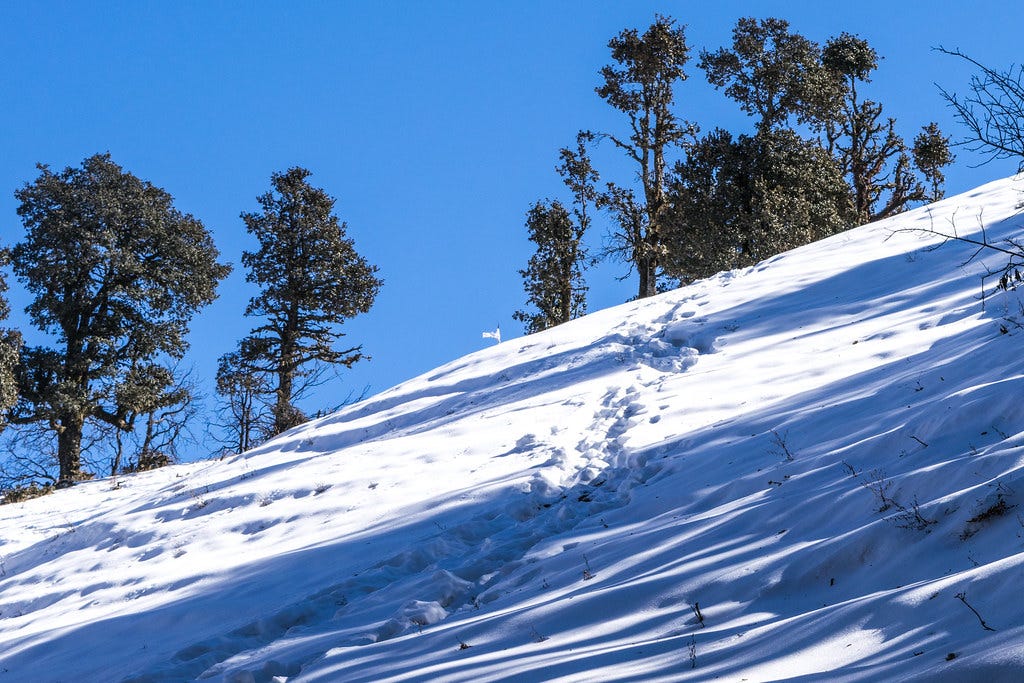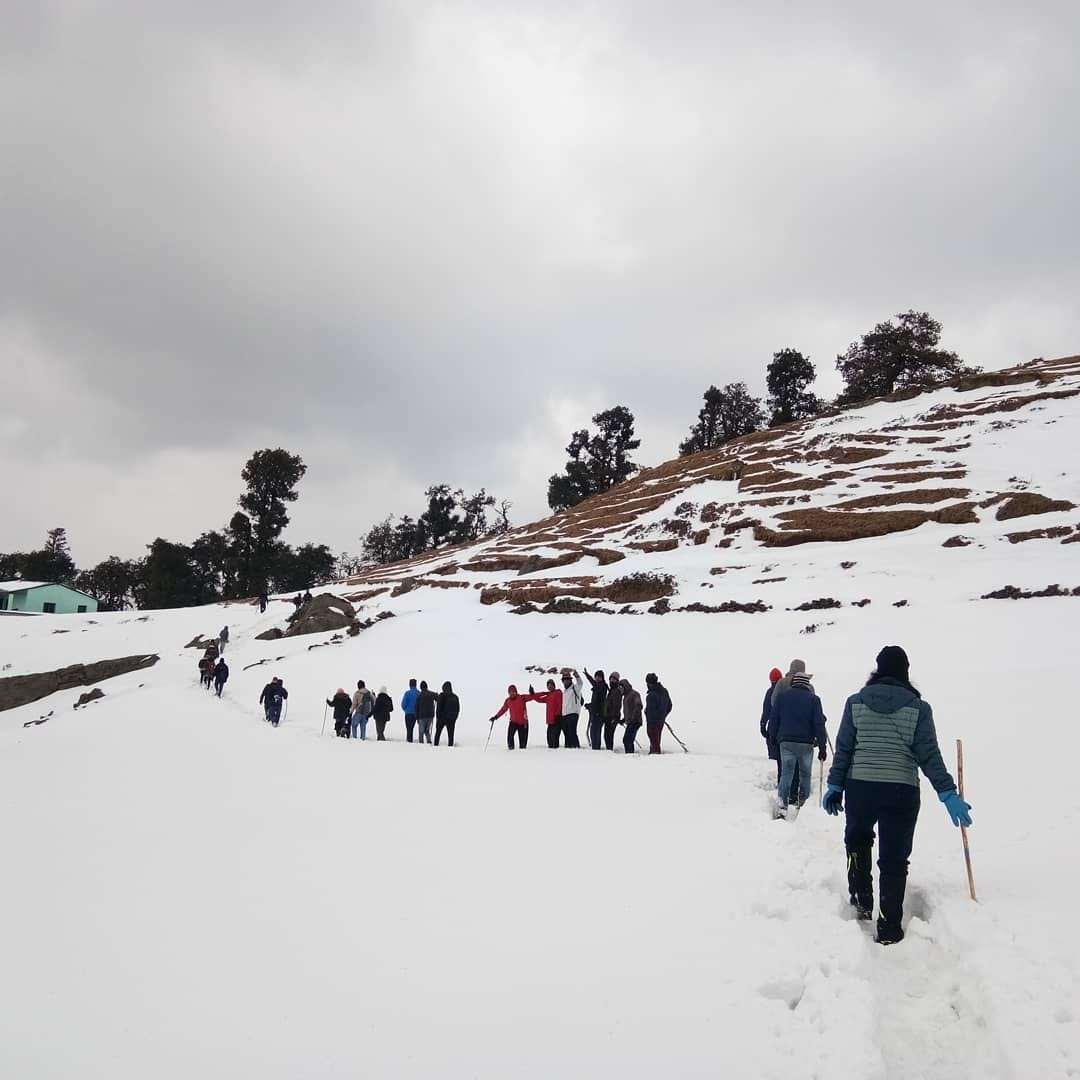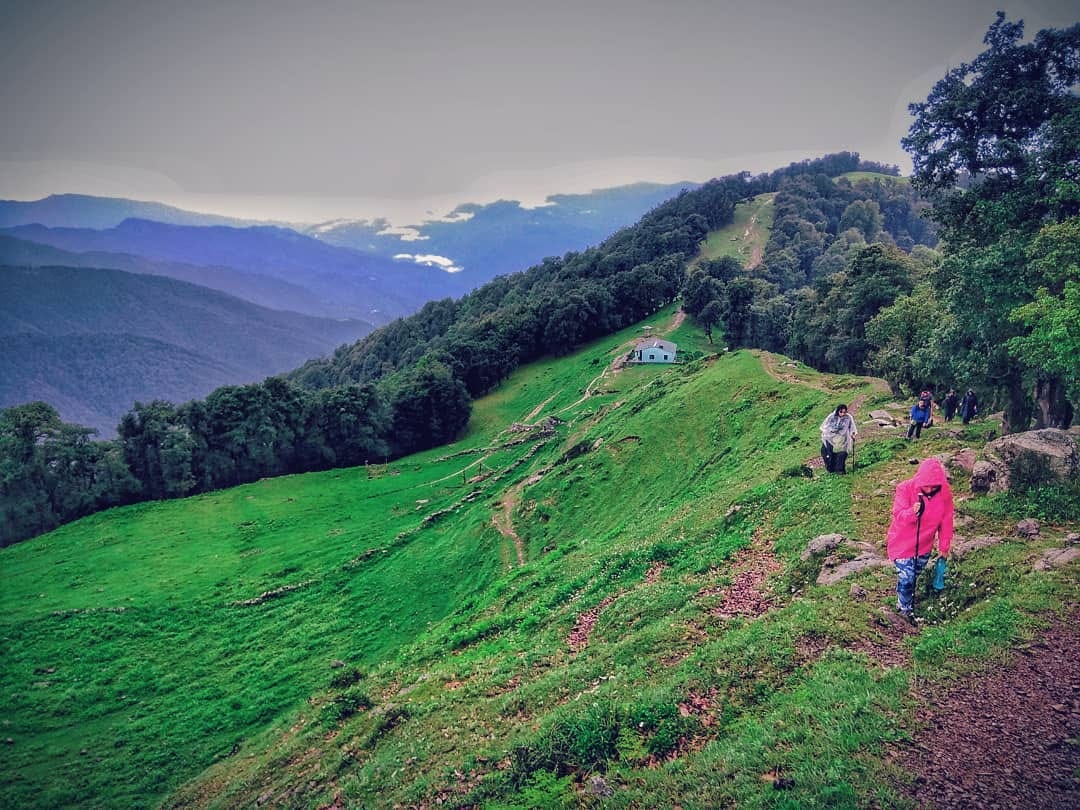I read somewhere that “If you see Sunrise and Sunset daily, that means you are the luckiest person” and today after a very long interval of time I saw that exceptional view of the sunrise from the Nag Tibba. I was exhausted and starving but it was a very small cost for this beautiful portrait of nature. We were lying down on the grass, watching the clear blue sky, and enjoying the calmness of that place.

But, how we get here?
Nag Tiibba trek was always in my bucket list when I heard it for the first time and finally, I got that chance to pull it out. One of my friends asked Would you like to join us for Nag Tibba Trek? Without thinking too much, I accept the proposal.
We were three and excited about this trip. We were gathered for making plans and on the spur of the moment, we decided the date, time and fixed the whole schedule for the upcoming weekend. Next few days we finished all our packing and on a Thursday night, we depart for Uttarakhand.
To reach Nag Tibba our first main stop is Dehradun. Dehradun is the place from where the actual journey starts. It is well connected with all means of transport. You can take the bus, Rail, and flight as well from Delhi.
Road — If you travelling from bus or cab it will take approx 6 to 7 hours to reach Dehradun.
Rail — Rail facilities are also available from Delhi to Dehradun on daily and alternate bases. You can choose it according to your convenience.
Air — If you want to take air experience or want to reduce time then this is the best option for you. It takes 45–60 min to reach Jolly Grant Airport Dehradun.

Route Plan for Nag Tibba -
Route 1- Dehradun -> Pantwari -> 8 Km trek to Nag Tibba and 3 km to Nag Tibba Summit
Route 2- Dehradun- >Mussoorie road-> Devalsari village -> 13 km trek to Nag Tibba
We depart for Dehradun at 10 pm from Delhi ISBT and we decide to follow the route-1
Day-1
At morning 4:15, we reached Dehradun bus stand but before we think about our next step, rain welcomed us in Dehradun. I don’t know about you but I’m really fond of untimely rain and tea. And without wasting any time, we head towards the tea stall. Sipping a cup of tea with watching drizzling and lots of silly talk with friends is always a wonderful time for me. After taking light snacks we were ready to move our next stop which was Pantwari village and luckily the rain was also stopped.
To get any public vehicle/transport for Pantwari you have to first visit Mussoorie station and from there you’ll get the transport for Pantwari. But we booked a taxi directly to Pantwari Village instead of going to Mussoorie -> Naina Bagh village
At 5:30 we head towards the Pantwari Village. It was a beautiful morning where sun yet not appeared, the breeze was flowing, which opens our sleepy eyes and introduced the freshness of this place. We left the Dehradun behind. Here the road was smooth and the window showing the changing colours of the landscape. One side with long pine trees and other side shows the yellowish fields where people are working. By looking at these mesmerizing view, we didn’t realize the pace of time and approx 9 am we reached that place where the actual trek starts for Nag Tibba.
At 9:30 we start our trek and one of my friend leading us from the front because he visited there before and have a better idea about route rather than us. That’s why we didn’t hire a guide. But make sure if you are visiting for the first time then you should hire a guide.

Why I’m saying this?
Nag Tibba trek is 8–9 km long which is full of twists and turns, which go through the dense forest. Especially in winter when the whole area will be covered with a blanket of snow, then it is quite difficult to find out and be on the right path. And your one wrong step takes you to where nobody wanted to stuck which is full of wild creatures.
We were moving to our base camp but our speed was quite slow because of all our camping stuff. It was quite hard but we were motivated and after 5 hours of trek, we reached to Nag Temple and we decided to pitch camp near Nag Temple. Nag Temple is 1 km before the peak which is dedicated to Nag Devta. Local villagers have the Great faith in Nag Devta. The local people have been offering prayers (puja) to the Snake God (Nag Devta) at this peak which is a testament to its sanctity. There is also a water source near the temple which you can use if you run out of water. But water is not very clean so make sure you boil it or use chlorine tablet before consumption.
Day-2
How often do you we get a chance to wake up with the chirping of birds and the view of glowing Himalayas? Maybe very few. That morning was amazing for us. We wake up at 4:45 and decided to head towards the Nag Tibba Summit for capturing the beautiful sunset view. We distribute the work. I was helping my friend in packing tents and another friend making tea for us. It took a complete 15 minutes to pack all our stuff. Now we had no time for tea. We pour the tea in a vacuum flask and decided to enjoy it at the summit with sunrise view.
At 5:02 we start the trek to the summit. The trail was going steeper and steeper after every single step. After struggling to reach the summit. Fortunately, we finally saw some flags waving in the air. We saw each other face with a devilish smile and without saying a single word, we ran to reach the top first. Yes, it sounds silly but was the memorable laugh for us. After 50 seconds of run, we were at the top. All were completely out of breathing. It was a bit of a climb but trust me, when you reach there you will forget every little step that you took.
There was still 3–4 minutes in the sunrise. We could see the beautiful Himalayan peaks like Nanda Devi, Bunderpunch, Chaukhamba, etc and after a couple of minutes, we witnessed the awesome sunrise from Nag Tibba.
And finally, there was time to go back home. This trip was not only for fun, but it’s about taking new experience, knowing our capability, and pushing our limits. Every time when I visit these type of places it proves me that “Life is…beautiful”.

Best time to Visit — Nag Tibba is a weekend destination, so it is accessible throughout the year.
Summer (April to June) — In the summer season, Nag Tibba offers clear view of surrounding hills and mountains. The weather is pleasant in a day but after evening temperature goes down so it is better to carry light woollen clothes.
Monsoon (July, August, mid-September) — In Monsoon season, you’ll find everything painted with the green colour. Sometimes you’ll see trees are loaded with red wine colour’s flowers which makes your trek more scenic. But rain can interrupt you during the trek so don’t forget to carry raincoats and waterproof bags.
Winter Season (December to February) — In Winters, you’ll find everything covered with a white blanket of snow which enhances the charm of Nag Tibba and attract more tourists/trekkers.
For more details- Click here
Comments